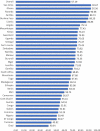Factors associated with the use of antibiotics for children presenting with illnesses with fever and cough obtained from prescription and non-prescription sources: a cross-sectional study of data for 37 sub-Saharan African countries
- PMID: 38641808
- PMCID: PMC11031913
- DOI: 10.1186/s12889-024-18490-1
Factors associated with the use of antibiotics for children presenting with illnesses with fever and cough obtained from prescription and non-prescription sources: a cross-sectional study of data for 37 sub-Saharan African countries
Abstract
Introduction: Fever and cough in under-five children are common and predominately self-limiting illnesses. Inappropriate prescribing of antibiotics in sub-Saharan Africa is a significant public health concern. However, prescription sources and use among children with fever or cough have not been explored. Therefore, we explored the factors associated with the use of antibiotics obtained from prescription and non-prescription sources for children with illnesses associated with fever and cough.
Methods: A secondary data analysis was conducted based on the Demographic and Health Survey (DHS) data from 37 sub-Saharan African countries. A total weighted sample of 18,866 under-five children who had a fever/cough and took antibiotics were considered for this study. Given the hierarchical nature of DHS data and the use of antibiotics prescribed from the formal healthcare setting (> 10%), a multilevel modified poisson regression model was fitted. Deviance was used for model comparison and the model with the lowest deviance value was chosen as the best-fitted model. Variables with p ≤ 0.2 in the bivariable analysis were considered for the multivariable modified poisson regression model. In the multivariable multilevel modified poisson regression model, the Adjusted Prevalence Odds Ratio (APOR) with a 95% Confidence Interval (CI) and p-value < 0.05 were reported to declare a significant association with taking antibiotics for fever/cough prescribed from formal healthcare setting.
Results: In sub-Saharan Africa, the proportion of use of antibiotics from informal healthcare setting for fever and cough among under-five children was 67.19% (95% CI: 66.51%, 67.85%). In the multilevel modified poisson regression analysis; residing in a rural area (APOR = 1.08, 95% CI: 1.04, 1.12), a child aged 36-47 months (APOR = 0.94, 95% CI: 0.90, 0.98), a child aged 48-59 months (APOR = 0.89, 95% CI: 0.84, 0.94), maternal primary education (APOR = 0.96, 95% CI: 0.93, 0.99), maternal secondary education (APOR = 0.95, 95% CI: 0.92, 0.99), belonged the middle household wealth status (APOR = 1.07, 95% CI: 1.02, 1.11), maternal exposure to news/electronic media (APR = 1.06, 95% CI: 1.02, 1.10), being from a household with 2 under-five children (APR = 0.94, 95% CI: 0.91, 0.97), being from a household with 3 under-five children (APR = 0.89, 95% CI: 0.85, 0.93), being from a household with 4 under-five children (APR = 0.90, 95% CI: 0.83, 0.98), and children of caregivers who were not involved in decision-making for their child health issues were significantly associated with taking antibiotics prescribed from formal healthcare setting for fever/cough among under-five children.
Conclusion: Only two-thirds of the antibiotics used for children under five who had fever and cough were prescribed from formal healthcare setting. Our findings underscore the significance of addressing healthcare disparities, improving access to qualified healthcare providers, promoting maternal education, and empowering mothers in healthcare decision-making to ensure appropriate antibiotic use in this vulnerable population. Further research and interventions targeted at these factors are warranted to optimize antibiotic prescribing practices and promote responsible antibiotic use in the management of fever and cough in under-five children.
Keywords: Antibiotics; Cough; Fever; Modified poisson regression analysis; Sub-Saharan Africa; Under-five children.
© 2024. The Author(s).
Conflict of interest statement
The authors declare no competing interests.
Figures
Similar articles
-
Antibiotic prescription sources and use among under-5 children with fever/cough in sub-Saharan Africa.Int Health. 2025 Jan 3;17(1):94-104. doi: 10.1093/inthealth/ihae026. Int Health. 2025. PMID: 38546432 Free PMC article.
-
Factors associated with mother's healthcare-seeking behavior for symptoms of acute respiratory infection in under-five children in sub-Saharan Africa: a multilevel robust Poisson regression modelling.BMC Health Serv Res. 2023 Oct 5;23(1):1061. doi: 10.1186/s12913-023-10065-x. BMC Health Serv Res. 2023. PMID: 37794438 Free PMC article.
-
Prompt treatment of fever and its associated factors among under-five children in sub-Saharan Africa: A multilevel analysis of evidence from 36 countries.PLoS One. 2024 May 16;19(5):e0303680. doi: 10.1371/journal.pone.0303680. eCollection 2024. PLoS One. 2024. PMID: 38753676 Free PMC article.
-
Prevalence and determinants of severity levels of anemia among children aged 6-59 months in sub-Saharan Africa: A multilevel ordinal logistic regression analysis.PLoS One. 2021 Apr 23;16(4):e0249978. doi: 10.1371/journal.pone.0249978. eCollection 2021. PLoS One. 2021. PMID: 33891603 Free PMC article.
-
Non-prescription antibiotic use and its predictors among children in low- and middle-income countries: a systematic review and meta-analysis.Ital J Pediatr. 2024 Dec 18;50(1):260. doi: 10.1186/s13052-024-01808-5. Ital J Pediatr. 2024. PMID: 39696454 Free PMC article.
References
-
- Their, A.S.P.I., A.A. Lives, and A.F.A.F.O. All. Managing the child with a fever. Practitioner. 2015;259(1784):17–21. - PubMed
-
- Adiele JA. Knowledge, perception and health-seeking behaviour relating to childhood diarrhoea among mothers of under-five children in Eni-Osa community Ibadan, Oyo State, Nigeria . 2019.
MeSH terms
Substances
LinkOut - more resources
Full Text Sources
Medical
Miscellaneous


